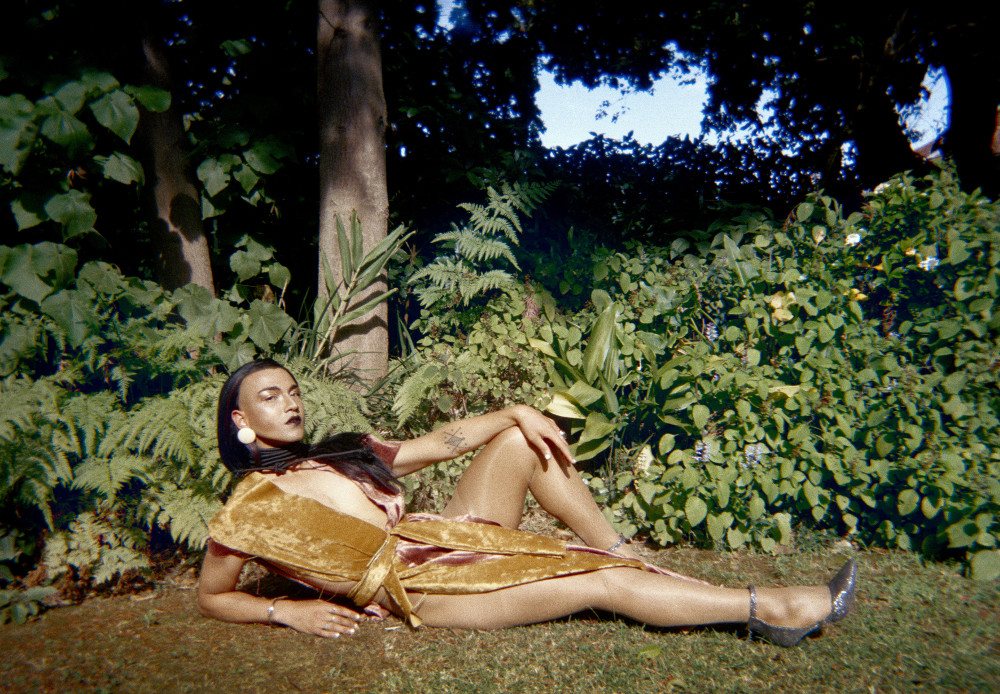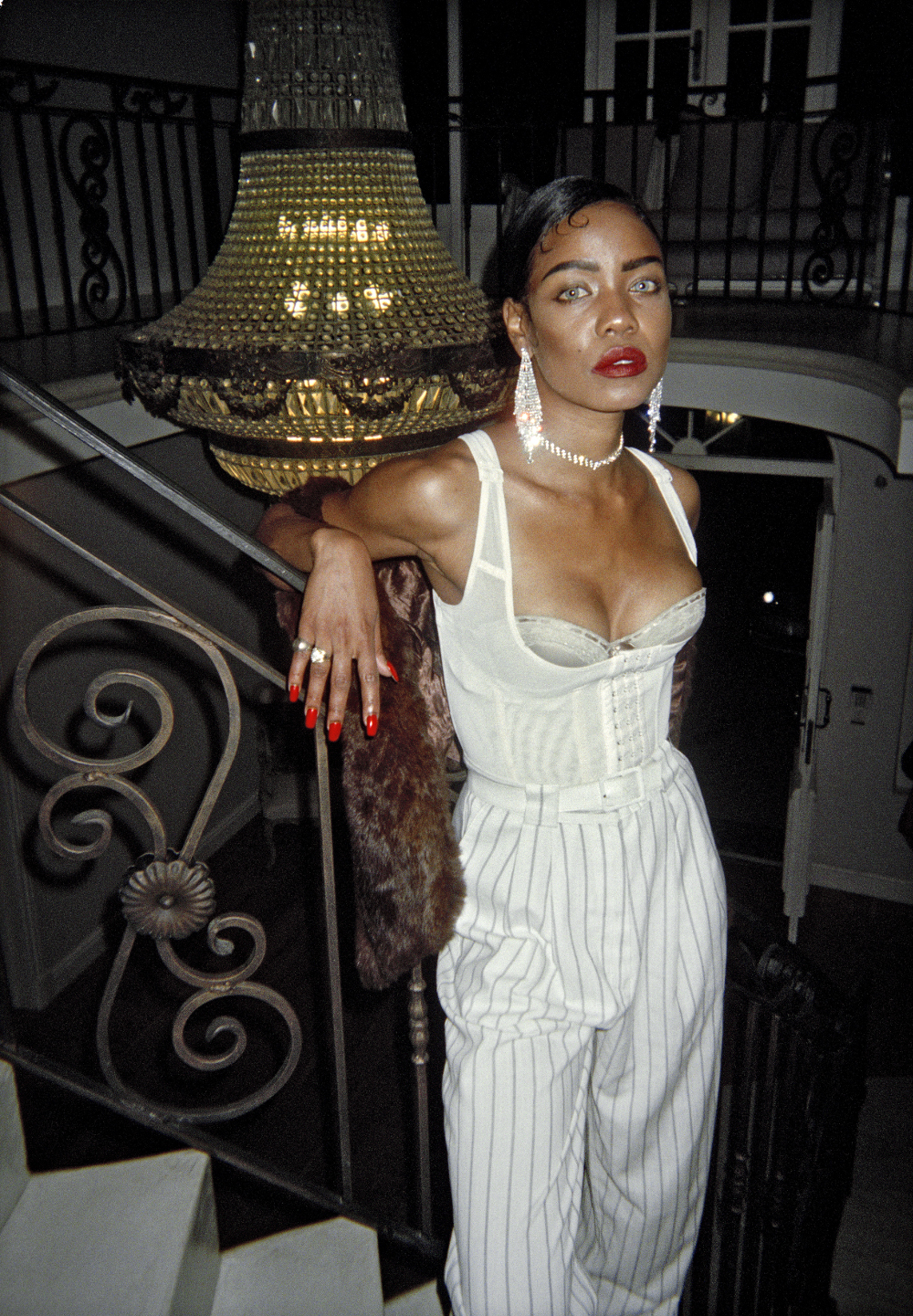'I Was Here' from Jody Brand’s exhibition You Can’t Keep a Good Woman Down
From the images collected on her Tumblr page Chomma, one can tell how much friendships have been a catalysing force in Jody Brand’s trajectory as an artist. The Cape Town-based photographer and visual artist’s oeuvre stands at the intersection of popular culture and visual archiving.
With You Can’t Keep A Good Woman Down, her first solo show with the Stevenson, Brand turns to friends to create images that are at once reclamatory, uplifting and glamorous. The large-scale images, many ranging around 2m by 3m, although initially subtle in their power, take on an urgent tone once their backstories are factored into their reading. Of particular interest in this regard is Moffie in Irma’s Garden, which derives much of its defiance from being taken spontaneously at the Irma Stern museum.
Jody Brand and Ziyanda Majozi are the 2017 recipients of a Thami Mnyele award in honour of Zanele Muholi’s upcoming show at Stedelijk Museum in Amsterdam. The award will see the trio work closely together. Brand spoke to the Mail & Guardian a day before jetting off.

[Moffie in Irma’s Garden]
The images in your show are all self-contained and yet work well as part of a whole.
Each image is particular to the experience of the particular subject. Each image comes from my exchange with the particular subject, which extends further than just taking the picture. These are my friends, my sisters, people I have known for a very long time from different parts of my life. A lot of my style is influenced by popular culture but also I wanted something that was glamorous. I feel it is similar to my experience as a South African as well to have all these multiple references.
Are the images shot using different cameras?
Everything was shot with a disposable camera. I have been using film and disposable cameras for a very long time because it is what was accessible to me.
I prefer to use point-and-shoot cameras because photography, as a medium, is always going to be problematic. You are always dealing with a gaze. To remove a big lens out of the exchange, to introduce something that people feel safer around, allows me to have a better exchange with my subjects. It is also what I am most familiar with.
That glamour is quite palpable throughout but quite distinct in Wolfie Rising. I was intrigued by the title and setting.
Most of the images are shot intervention style where we choose a location and then insert ourselves into the space. We occupy it. This is [one of] the only one[s] that was planned, in that we got permission, because we were in someone else’s home.
The image is of a very close friend of mine and the name Wolfie is one that she has given to herself. I’m just trying to lift people from their everyday reality, which is quite grim and it can look like there isn’t any future or hope, to create something that is fictional or fantasy.

[Wolfie Rising]
Victoria Acerta is something I associate with political sloganeering. I was struck by the contrast between the title and the image.
What we are doing is highly political.
The subject in the image wears red satin gloves, has a confrontational stare and poses quite magnetically in front of a plant bed, as if announcing her claim over newly conquered territory. Is that location of particular significance, especially given the fact that she is naked?
That location was chosen just to make my subject comfortable. It was a family friend’s home, whereas the other locations were more to disrupt the space. This one wasn’t the case because she was choosing to make herself vulnerable by being naked. I didn’t want to, on top of that, expose her to potential violence — if that did happen — in a public space.
It is the first time I have worked with full nudity and it is something I was, before, uncertain about. But I have been doing so much research and learnt so much about the femme body being a site of resistance, especially in African societies. Women, in protest, have used their bodies, stripping naked to force people to reckon with what they are saying. It has happened multiple times recently in South Africa during the Fallist protests. For me to envision a black femme body being empowered and actually returning the gaze is something highly political.
My Ma se Kind has a very dreamlike quality, creating a feeling of absence.
Well, it is the subject’s place of work. She works in a boutique servicing upper middle-class clientele, which she is not a part of. In my own experience, working in retail and service positions, especially in Cape Town, you have to deal with a lot of microaggressions that will have you feeling like you are not valid or worthy of sharing spaces with such people.
So to have her inside the space, owning the space, is something I am constantly trying to re-enact.
The background to I Was Here is quite uniquely dramatic in a way that I guess is mirrored in your subjects’ poses.
The image was shot at the Company’s Garden, which was created by the Dutch East India Company as a vegetable garden they could use en route. The people in the images are homeless and they live in the Company’s Garden. This is also their home.
Are these the glimpses of a much larger body of work?
There were seven, I showed five. I am in the beginning stages of a project I see going on for quite some time. So the work isn’t just the taking of the picture. A lot of it is my friendships with these people, our sharing with each other, our experiencing of life together, which entails a lot of emotional labour. What I am really focused on with this work is trying to find strategies of survival for femme-identifying people in a world that is not meant for their survival. People are dying and it is not just art. It is life and death.
Can you talk about the inspiration behind the installation that is part of the exhibition?
For the [group show] The Quiet Violence of Dreams I did a series of installations called Say Her Name, which spoke directly about the murder of Nokuphila Khumalo [who was beaten to death by artist Zwelethu Mthethwa]. Reading all the instances of sexual violence and especially how patriarchy plays into all of that in the book, and thinking about [the location of] the Stevenson gallery in Woodstock, I could not stop thinking about Nokuphila.
It is just something that sat with me, that a photographer within my art community [could have committed this act]. Even though I have never engaged with Zwelethu Mthethwa, I found it completely urgent and necessary to address because nobody else wanted to at that stage.
In an article I read, Nokuphila’s mother wanted to lay pink and white roses where her daughter had died because those were her daughter’s favourite. I wanted to create work that touched on a mother’s suffering. In Cape Town, I suspended pink and white roses from the ceiling, which dried over the course of the exhibition. They really had a lot of presence.
I use the roses that were left over this time — but it is new work. I created a space that is a chapel and I’m inviting the viewers to atone for the violence enacted on black and brown femme bodies every day in this country.
You Can’t Keep A Good Woman Down runs at the Stevenson, 160 Sir Lowry Road, Woodstock, Cape Town, until July 15